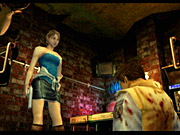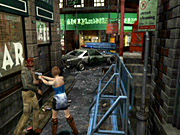Until Resident Evil 0, the original version of Resident Evil 3 represented the most drastic departure from the traditional Resident Evil formula, at least in terms of gameplay mechanics. Not only was it possible to essentially manufacture your own ammunition, but the game's main character, Jill Valentine, could perform a variety of defensive maneuvers, including a side step, that made combat a little more forgiving and even a little more exciting. Unfortunately, Resident Evil 3 didn't flow quite as well as other games in the Resident Evil series, with puzzles seemingly strung together in a slightly more chaotic fashion. All of these features have made the full transition to the GameCube version, along with the slight visual enhancements that were originally constructed for the Dreamcast version of the game, and as such, it's really intended for those who have never played any version of Resident Evil 3 before. But even those people should be aware of the game's relatively high retail price and should seriously consider Resident Evil 3 for the GameCube as a rental-only prospect.

Resident Evil 3: Nemesis takes place shortly after the events in the original Resident Evil, and unlike Resident Evil 2, it focuses on a character from the original game named Jill Valentine. Jill finds herself trapped within Raccoon City as the T-virus continues to spread and infect even more of the locals, changing average groups of people into a slinking army of zombies. Jill has to explore what's left of Raccoon City (including the police department featured in Resident Evil 2), locate survivors, and, more importantly, find safe passage out of the city. All the while, an enormous superzombie named Nemesis (charged with killing the remaining members of the S.T.A.R.S. unit involved in the events in the original Resident Evil) continually stalks Jill and will make an appearance in various areas of the game. The storyline in Resident Evil 3 doesn't shed much light on the Resident Evil story as a whole, focusing mainly on what's happening to Jill and on a few of the events that have transpired in Raccoon City, which almost makes it feel as though it's not really a part of the Resident Evil timeline. Still, those who have played the Resident Evil remake will undoubtedly want to find out what happens to one of the series' main protagonists.
Interestingly, that sense of detachment seems to apply to Resident Evil 3's gameplay mechanics, which underwent a few changes that aren't present in any subsequent Resident Evil game. The controls are still set up so that controlling Jill is similar to controlling a tank, which can make combat and basic maneuvering a little irritating. Resident Evil 3, however, introduces the 180-degree turn that lets you turn Jill in the opposite direction on the fly instead of wasting a few precious seconds to turn her around manually. In addition, Jill also has a dodge move that enables her to perform a little side step when enemies are about to pounce. Both of these moves are incredibly useful, particularly when dueling with Nemesis, though the dodge move can occasionally become cumbersome since Jill will perform the side step instead of firing her weapon at close range, which usually results in more damage.
Another unique aspect of Resident Evil 3, when compared to other games in the series, is the ammunition system. In essence, Jill can create all sorts of ammunition by mixing different types of gunpowder. Like making some sort of crazy milkshake, if you mix gunpowder A with gunpowder B, you get gunpowder C, which can then be transformed into grenade launcher ammunition. Or if you simply want more handgun bullets, you put gunpowder A into the mixer by itself. This essentially frees you from having to monitor ammunition as closely as you would in other Resident Evil games, because you can make what you need, but you will need to monitor your gunpowder level and be sure to conserve it later in the game. The inventory and save systems still function as they did in all of the other Resident Evil games (with the exception of Resident Evil 0), forcing you to store items in a chest so you can access them later at a different save point.
You'll be using the item chest quite often, probably more so than in any other Resident Evil game, because the puzzles aren't quite as intuitive or inspired, which makes it difficult to predict which items you should store. Resident Evil 3 has a tendency to just throw several important items at Jill within a short period of time and then leave you to guess where these items might come in handy, so you can expect to run around in circles and do a significant amount of backtracking. Of course, much of this has to do with the haphazard level design that attempts to transform an entire city into something that feels like the mansion, police station, or centralized locations in other Resident Evil games.
The environments in Resident Evil 3 for the GameCube look marginally better than those in the GameCube version of Resident Evil 2, but that's to be expected considering that the original Resident Evil 3 came out a year after its predecessor. However, it's worth noting that they still look quite bad in comparison to what Capcom has been able to accomplish with the remake of the original Resident Evil and with Resident Evil 0. In addition, the character models still look very poor and have all sorts of rough edges and weird joint problems.

As for sound, Resident Evil 3 should put a scare or two into anyone who's never played the game before. All of the usual screams, zombie grunts and groans, and various environmental sound effects are present in the game, but perhaps the most noteworthy aspect of the game's aural presentation is the music--whenever Nemesis drops into a room, the music changes to a much more dramatic theme, and a subdued version of that theme will continue to play when Nemesis is still nearby. The voice acting is still pretty bad, but it does get the basic story elements across.
To put it simply, if you've never played Resident Evil 3: Nemesis, it's worth checking out this version as a rental just to experience some of the gameplay mechanics that aren't present in any other Resident Evil game. But it's still an incredibly dated port, and the fact that it retails for as much as a game made within the last year is quite despicable.